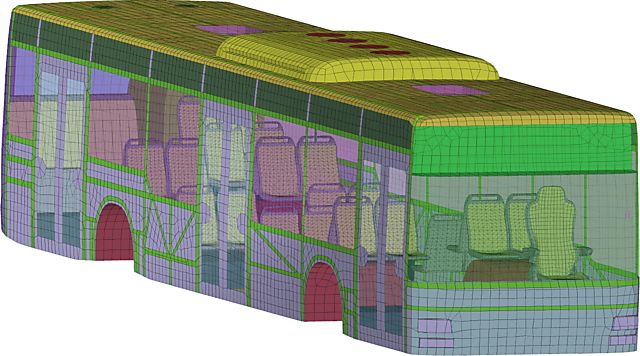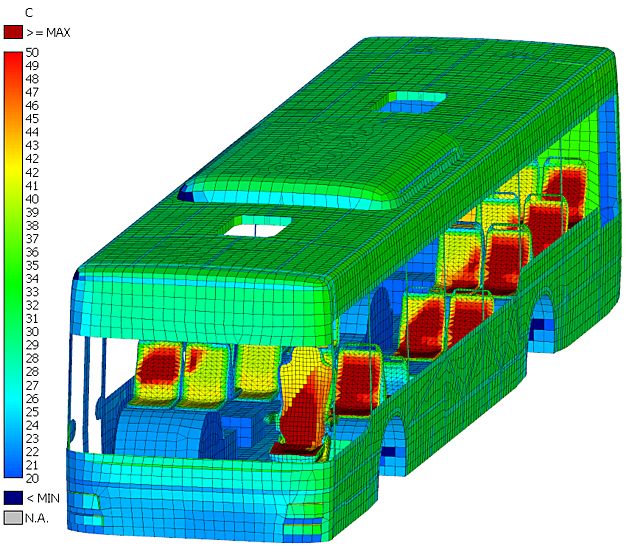Benefits gained through simulations of passenger compartments of public transportation vehicles

Be it busses, tramways, metro or passenger trains - THESEUS‑FE can be utilized to solve any thermal problems arising in and around public transportation vehicles. Application cases where THESEUS‑FE really shines are the thermal comfort assessment of passengers and analyzing energetic measures such as different glazings or heat insulation.
An overview of use cases where THESEUS‑FE can help to gain invaluable insight for public transportation:
-
Simulating the power of HVAC systems on summer or winter days with extreme climate conditions, so-called worst-case scenarios
Typical questions in this regard are:
- How high does the volume flow and inlet temperature of the HVAC system need to be to maintain a comfortable temperature level in the whole passenger compartment or to reach it within a pre-defined period of time?
- Is a homogeneous heating of the whole passenger cabin possible to guarantee an adequate comfort level on all seats?
-
Localization of thermal bridges in the passenger compartment
- Where and why do the highest heat flows arise?
- Comparison of different measures for local heat insulation
- Dimensioning of novel radiant heating panels as an alternative to classical HVAC concepts.
- Calculation of possible energy savings to provide a basis for a cost-benefit analysis
- Comparison of different glazing variants regarding their energy efficienty in typical summer and winter load cases. These simulations usually consider wavelength-dependent transmission and absorption of glazings as well as time-dependent solar loads based on the relative movement of the sun.
- Cost-benefit analysis of full year simulations on various places on earth. Mathematical models for sun intensity and sun position as well as other environmental conditions are used in this case.
-
Additional questions which can be answered by simulations with THESEUS‑FE are:
- Are there any risks for local moisture condensation in cavities of the cabin construction or within insulation bodies
- Influence of engine waste heat on the climatization of the passenger compartment
- Are there any hot areas with a potential risk of injury on the surfaces of the passenger cabin
Case study: MAN Bus A37 - HVAC Analysis & Benchmark with THESEUS‑FE
In a joint project with MAN, Volkswagen, and the University of Applied Sciences, Munich, we have developed a THESEUS‑FE model for predicting the HVAC performance of an MAN A37 City Bus.
Our main focus was on the validation of the THESEUS‑FE model with an existing Excel-based tool developed by F. Artmeier at MAN Truck & Bus.
Project description

Aim of the project was to demonstrate the capabilities of THESEUS‑FE for simulating a bus air conditioning system. The main goal of the simulation was to derive the net power of the HVAC system needed to enforce a contant value of 20 °C cabin temperature.
In a first step we validated the Finite Element results of THESEUS‑FE by comparing them with the results obtaining using an MAN in-house tool. The MAN tool, developed and tested by Mr. Felix Artmeier as part of his diploma thesis in 2012, considers energy balances for the bus cabin. In a second step we demonstrated the advantage of employing THESEUS‑FE by creating an extended simulation model also capable of simulating passenger thermal comfort. Finally we validated the THESEUS‑FE prediction of AC power using a Mollier diagram.
Model setup and results

THESEUS‑FE permits all kinds of thermal boundary conditions such as conduction, convection, and radiation.
The overall intent of the simulation was to derive the net power of the HVAC system needed to enforce a constant value of 20 °C cabin temperature (Tcabin) typical climate conditions for a summer day in Germany.
For the extended THESEUS‑FE model we added seats and additional heat sources such as passenger metabolism and engine heating.
The project clearly demonstrated that THESEUS‑FE is a useful simulation tool in designing a bus AC system. Environmental conditions for any place on earth are easily integrated into the model. The results were more than satisfactory and confirm the role of THESEUS‑FE as an established and reliable tool in predicting vehicle cabin HVAC parameters.
Related publications available as free download
MAN Bus A37: HVAC Analysis & Benchmark with THESEUS-FE
[english, 3.0 MB]
S. Paulke, F. Artmeier, K.-E. Yildirim, V. Bader, A. Gubner
P+Z Engineering, MAN Truck & Bus AG, Volkswagen AG, TU Munich
Project Report | August 19, 2013
Numerical Simulation of the Air Flow and Thermal Comfort in a Train Cabin
[english, 1.3 MB]
M. Konstantinov, C. Wagner
TU Ilmenau, DLR Göttingen
2014
Contra Vision bus window wraps - HVAC case study using THESEUS-FE
[english, 0.8 MB]
Contra Vision
Contra Vision
November, 2019





